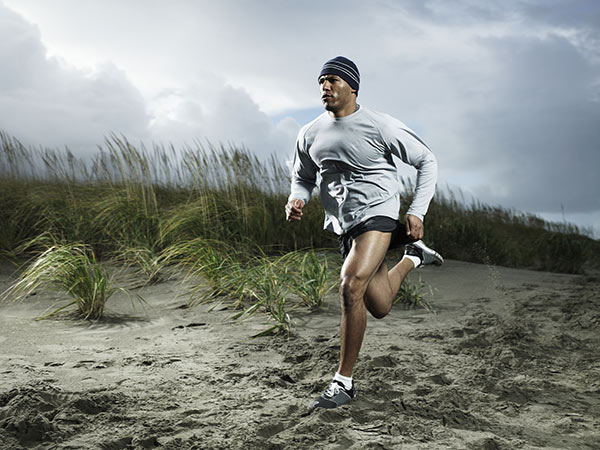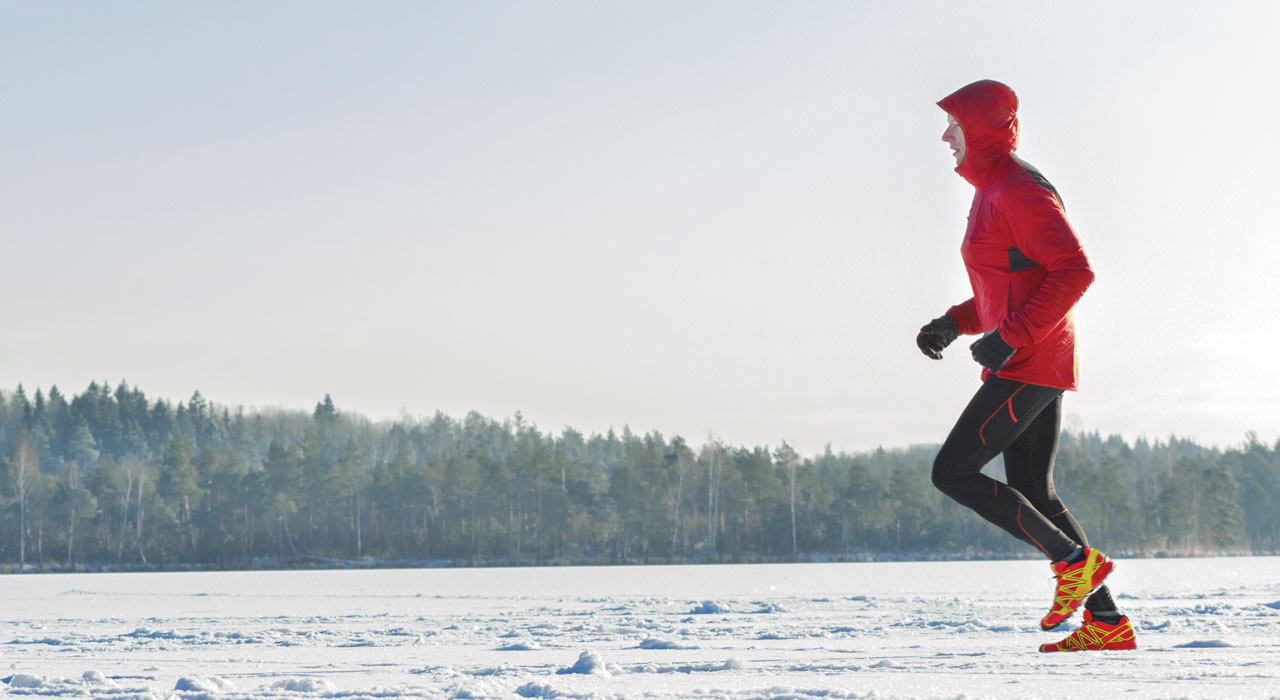To prepare for his event, Kris Gethin hits the snow trails for hours. Here’s how to conquer the white mountains so your fitness doesn’t slide when the mercury does. It’s time to master cold weather running.
Hip flexors will need strengthening
The hip flexors have to work very hard during long-distance running, especially with athletes who have muscular legs.
This problem is exacerbated in the snow because you need to lift your knees higher to get enough clearance with each stride, avoiding stumps, routes and rocks hidden in the snow.
Once fatigue sets in this can affect rhythm, which leads to shuffling as the hip flexors struggle to lift the legs high enough.
The posture can also slump forward and your center of gravity can become affected.
To condition the hip flexors for snow running, I use Spiderman climbs and adopt an exaggerated high-knee running technique. Building core strength with the plank also results in better posture, helping reduce the chances of leaning forwards in the run.
Traction is safety for cold weather running
While running in snow there is less traction, which can increase the chances of slipping and injury, especially for big athletes who are top heavy, yet have the same size ankles and feet as the average man.
To reduce the chances of slipping I use traction devices such as Yaktrax.
They clamp onto the bottom of my feet to help reduce the risk of slipping. With heavy athletes who carry more muscle, there’s a vulnerability to muscle tears when falling over.
By taking appropriate measures to improve traction, it’s possible to limit these risks.
Layers are crucial
In the snow it’s easy to layer up too much so personally, I use a maximum of three.
This will consist of a thin breathable pullover, a tight skin underneath and perhaps a windproof coat if needed.
The outer layers will be thin so I can remove them and tie them around my waist.
It is said 30% of heat escapes from the head, but a lot is lost from your neck, too. To prevent this, I use a Buff neck glove.
It can also go over my chin and nose if needed for added warmth.

Stoke the engine room
Forgetting to eat and drink enough is common in the hot weather, but it’s truly unforgivable when cold weather running. There is little moisture here, so it’s even easier to become dehydrated.
Initially, the body and brain don’t necessarily recognize it because the sweat evaporates so fast.
This is why I make sure the two liters of water within my CamelBak is spiked with Kaged Muscle Hydra-Charge, which provides me with potassium, calcium, phosphorus, magnesium and sodium, which support electrolyte balance to prevent cramping.
As a bodybuilder, I also recommend including fermented BCAA’s and fermented glutamine.
More calories are expelled during the cold weather due to shivering and temperature regulation; this is why it’s important to eat additional energy.
All I do is eat more of the same healthy natural ingredients, which my diet consists of. There is a great company called Picky Bars that are calorie dense with all natural ingredients.
These sit well in the stomach and are easy to digest while running.
Safety comes first
I like to use the Strava app – a social network for endurance activities. It lets me provide my parents and girlfriend with my beacon, which is shared from the app to their phones.
This allows them to follow me on my trail runs. Often I don’t know what direction I’m heading or the area I’m running in, but knowing that at least three people are able to track me gives me reassurance I’m safe in the event of an emergency.
It also provides some extra accountability. Snow running is great fun and can be done through snowmobile trails, Nordic skiing routes or trails that have been packed down by other runners.
It definitely encourages exploration, and that is also great for the mind!
Adjust your expectations
Don’t expect the same mileage when snow running, as it’s far more demanding.
Gradually increase mileage every couple of weeks so you adapt to the conditions and count each mile as “double” compared to normal surface running when assessing times.
In my experience, it’s one of the best aerobic conditioning activities to pursue, just go prepared using the advice given above.
For more content about cold weather running, nutrition tips, and training advice, get TRAIN magazine direct into your inbox every month for free by signing up to our newsletter







